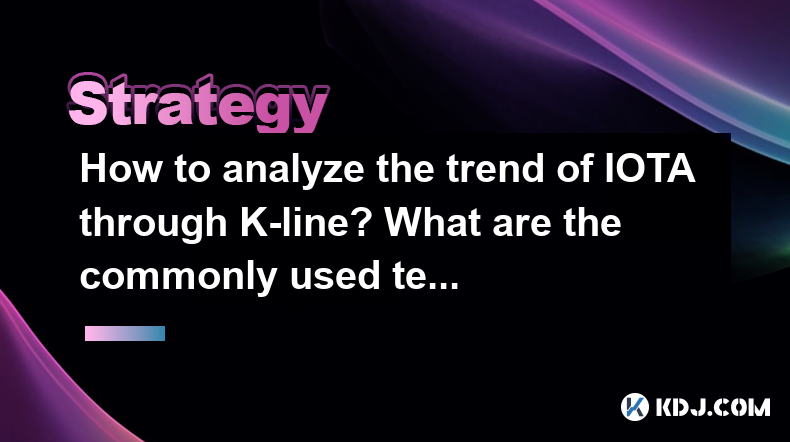-
 bitcoin
bitcoin $118548.520763 USD
3.67% -
 ethereum
ethereum $4352.564943 USD
4.79% -
 xrp
xrp $2.964058 USD
4.22% -
 tether
tether $1.000565 USD
0.05% -
 bnb
bnb $1028.372955 USD
1.46% -
 solana
solana $221.373507 USD
6.00% -
 usd-coin
usd-coin $0.999933 USD
0.02% -
 dogecoin
dogecoin $0.248633 USD
6.85% -
 tron
tron $0.341444 USD
2.38% -
 cardano
cardano $0.852946 USD
5.82% -
 hyperliquid
hyperliquid $47.869306 USD
6.15% -
 chainlink
chainlink $22.561476 USD
6.01% -
 ethena-usde
ethena-usde $1.001258 USD
0.05% -
 avalanche
avalanche $30.660000 USD
2.06% -
 stellar
stellar $0.400917 USD
9.76%
How to analyze the trend of IOTA through K-line? What are the commonly used technical indicators?
IOTA uses the Tangle for feeless transactions; traders analyze its trends with K-line charts and technical indicators like MA, RSI, Bollinger Bands, and MACD.
May 04, 2025 at 08:01 am

Introduction to IOTA and K-line Analysis
IOTA is a distributed ledger technology designed to support the Internet of Things (IoT). Unlike traditional blockchains, IOTA uses a directed acyclic graph (DAG) called the Tangle, which allows for feeless transactions and scalability. Analyzing the trend of IOTA through K-line charts is a common practice among traders and investors to understand the price movement and make informed decisions.
K-line charts, also known as candlestick charts, are graphical representations of price movements over time. Each K-line represents the open, high, low, and close prices for a specific period. By analyzing these charts, traders can identify patterns and trends that help in predicting future price movements.
Understanding K-line Basics
A K-line consists of a body and wicks (or shadows). The body of the K-line represents the range between the opening and closing prices, while the wicks represent the highest and lowest prices during the period.
- Bullish K-line: If the closing price is higher than the opening price, the body is usually colored green or white.
- Bearish K-line: If the closing price is lower than the opening price, the body is usually colored red or black.
To analyze the trend of IOTA using K-line charts, traders look for patterns such as doji, hammer, engulfing, and piercing patterns, which can indicate potential reversals or continuations in the trend.
Identifying Trends with K-line Patterns
Trend analysis involves identifying the direction of the market movement. By observing the sequence of K-lines, traders can determine whether the market is in an uptrend, downtrend, or sideways trend.
- Uptrend: Characterized by a series of higher highs and higher lows. K-lines will generally show more bullish patterns.
- Downtrend: Characterized by a series of lower highs and lower lows. K-lines will generally show more bearish patterns.
- Sideways Trend: Characterized by prices moving within a horizontal range. K-lines may show alternating bullish and bearish patterns without a clear direction.
Commonly Used Technical Indicators for IOTA
Technical indicators are mathematical calculations based on the price and/or volume of a security. They help traders confirm trends, identify potential reversals, and make trading decisions. Here are some commonly used technical indicators for analyzing IOTA:
Moving Averages (MA)
Moving averages smooth out price data to create a single flowing line, making it easier to identify the direction of the trend. There are two main types of moving averages used in IOTA analysis:
- Simple Moving Average (SMA): Calculated by adding the closing prices of a security over a specified number of periods and then dividing by the number of periods.
- Exponential Moving Average (EMA): Similar to SMA but gives more weight to recent prices, making it more responsive to new information.
Traders often use the crossover of short-term and long-term moving averages to identify trend changes. For example, when a short-term EMA crosses above a long-term EMA, it may signal an uptrend.
Relative Strength Index (RSI)
Relative Strength Index (RSI) is a momentum oscillator that measures the speed and change of price movements. It ranges from 0 to 100 and is typically used to identify overbought or oversold conditions.
- Overbought: RSI above 70 indicates that IOTA may be overvalued and due for a price correction.
- Oversold: RSI below 30 indicates that IOTA may be undervalued and due for a price rebound.
Traders use RSI to confirm trends and look for divergence between RSI and price as a signal of potential reversals.
Bollinger Bands
Bollinger Bands consist of a middle band (usually a 20-period SMA) and two outer bands that are standard deviations away from the middle band. They help traders identify volatility and potential price breakouts.
- Narrowing Bands: Indicate decreasing volatility and may precede a significant price move.
- Widening Bands: Indicate increasing volatility and potential trend continuation or reversal.
Traders use Bollinger Bands to identify overbought and oversold conditions and to confirm trends when the price moves outside the bands.
MACD (Moving Average Convergence Divergence)
MACD is a trend-following momentum indicator that shows the relationship between two moving averages of a security’s price. It consists of the MACD line, signal line, and histogram.
- MACD Line: Calculated by subtracting the 26-period EMA from the 12-period EMA.
- Signal Line: A 9-period EMA of the MACD line.
- Histogram: Represents the difference between the MACD line and the signal line.
Traders use MACD to identify potential buy and sell signals. A bullish signal occurs when the MACD line crosses above the signal line, while a bearish signal occurs when the MACD line crosses below the signal line.
Practical Steps to Analyze IOTA Trends Using K-line and Technical Indicators
To effectively analyze the trend of IOTA using K-line charts and technical indicators, follow these steps:
- Select a Timeframe: Choose a timeframe that aligns with your trading strategy. Common timeframes include 1-minute, 5-minute, 15-minute, 1-hour, 4-hour, and daily charts.
- Open a K-line Chart: Use a reliable trading platform or charting software to open a K-line chart for IOTA.
- Identify the Trend: Observe the sequence of K-lines to determine the current trend. Look for higher highs and higher lows in an uptrend, lower highs and lower lows in a downtrend, and a range-bound movement in a sideways trend.
- Apply Technical Indicators: Add the chosen technical indicators to the chart. For example, add a 50-period SMA and a 200-period SMA to identify trend direction, and add RSI to identify overbought or oversold conditions.
- Analyze Patterns and Signals: Look for K-line patterns such as doji, hammer, and engulfing patterns, and monitor the technical indicators for signals. For example, a bullish engulfing pattern accompanied by an RSI below 30 may indicate a potential reversal.
- Confirm Signals: Use multiple indicators to confirm signals. For example, if the MACD line crosses above the signal line and the RSI is rising from an oversold condition, it may confirm a bullish signal.
- Make a Decision: Based on the analysis, decide whether to buy, sell, or hold IOTA. Always consider risk management and set appropriate stop-loss and take-profit levels.
Frequently Asked Questions
Q: Can K-line analysis be used for other cryptocurrencies besides IOTA?A: Yes, K-line analysis is a versatile tool that can be applied to any cryptocurrency. The principles of identifying trends and patterns using K-line charts remain the same across different assets.
Q: How often should I update my technical analysis for IOTA?A: The frequency of updating your technical analysis depends on your trading strategy and timeframe. Short-term traders may update their analysis multiple times a day, while long-term investors may update it weekly or monthly.
Q: Are there any risks associated with relying solely on technical analysis for IOTA trading?A: Yes, relying solely on technical analysis can be risky as it does not account for fundamental factors such as news events, regulatory changes, and market sentiment. It is advisable to combine technical analysis with fundamental analysis for a more comprehensive approach.
Q: Can I use automated trading systems for IOTA based on K-line and technical indicators?A: Yes, many traders use automated trading systems that are programmed to execute trades based on K-line patterns and technical indicators. However, it is important to thoroughly test and monitor these systems to ensure they perform as expected.
Disclaimer:info@kdj.com
The information provided is not trading advice. kdj.com does not assume any responsibility for any investments made based on the information provided in this article. Cryptocurrencies are highly volatile and it is highly recommended that you invest with caution after thorough research!
If you believe that the content used on this website infringes your copyright, please contact us immediately (info@kdj.com) and we will delete it promptly.
- BlockDAG, DOGE, HYPE Sponsorship: Crypto Trends Shaping 2025
- 2025-10-01 00:25:13
- Deutsche Börse and Circle: A StableCoin Adoption Powerhouse in Europe
- 2025-10-01 00:25:13
- BlockDAG's Presale Buzz: Is It the Crypto to Watch in October 2025?
- 2025-10-01 00:30:13
- Bitcoin, Crypto, and IQ: When Genius Meets Digital Gold?
- 2025-10-01 00:30:13
- Stablecoins, American Innovation, and Wallet Tokens: The Next Frontier
- 2025-10-01 00:35:12
- NBU, Coins, and Crypto in Ukraine: A New Yorker's Take
- 2025-10-01 00:45:14
Related knowledge

Practical parameter settings for a Bitcoin multi-timeframe moving average system
Sep 18,2025 at 10:54pm
Optimizing Timeframe Combinations for Bitcoin Trading1. Selecting appropriate timeframes is crucial when building a multi-timeframe moving average sys...

How can I filter out false breakouts in Dogecoin high-frequency trading?
Sep 22,2025 at 01:00am
Understanding False Breakouts in Dogecoin Trading1. A false breakout occurs when Dogecoin's price appears to move beyond a defined support or resistan...

Techniques for identifying tops and bottoms in the Bitcoin on-chain NVT model
Sep 20,2025 at 07:54pm
Understanding the NVT Model in Bitcoin Analysis1. The Network Value to Transactions (NVT) ratio is often described as the 'P/E ratio' of the cryptocur...

What does the surge in open interest in Bitcoincoin futures mean?
Sep 20,2025 at 11:18pm
Understanding the Surge in Dogecoin Futures Open Interest1. A surge in open interest within Dogecoin futures indicates a growing number of active cont...

How can I use the Ethereum USDT premium to gauge market sentiment?
Sep 18,2025 at 11:55pm
Understanding the Ethereum USDT Premium1. The Ethereum USDT premium refers to the price difference between USDT (Tether) traded on Ethereum-based plat...

What should I do if Ethereum staking yields decline?
Sep 20,2025 at 06:18am
Understanding the Causes Behind Declining Ethereum Staking Yields1. The Ethereum network transitioned to a proof-of-stake consensus mechanism with the...

Practical parameter settings for a Bitcoin multi-timeframe moving average system
Sep 18,2025 at 10:54pm
Optimizing Timeframe Combinations for Bitcoin Trading1. Selecting appropriate timeframes is crucial when building a multi-timeframe moving average sys...

How can I filter out false breakouts in Dogecoin high-frequency trading?
Sep 22,2025 at 01:00am
Understanding False Breakouts in Dogecoin Trading1. A false breakout occurs when Dogecoin's price appears to move beyond a defined support or resistan...

Techniques for identifying tops and bottoms in the Bitcoin on-chain NVT model
Sep 20,2025 at 07:54pm
Understanding the NVT Model in Bitcoin Analysis1. The Network Value to Transactions (NVT) ratio is often described as the 'P/E ratio' of the cryptocur...

What does the surge in open interest in Bitcoincoin futures mean?
Sep 20,2025 at 11:18pm
Understanding the Surge in Dogecoin Futures Open Interest1. A surge in open interest within Dogecoin futures indicates a growing number of active cont...

How can I use the Ethereum USDT premium to gauge market sentiment?
Sep 18,2025 at 11:55pm
Understanding the Ethereum USDT Premium1. The Ethereum USDT premium refers to the price difference between USDT (Tether) traded on Ethereum-based plat...

What should I do if Ethereum staking yields decline?
Sep 20,2025 at 06:18am
Understanding the Causes Behind Declining Ethereum Staking Yields1. The Ethereum network transitioned to a proof-of-stake consensus mechanism with the...
See all articles










































































